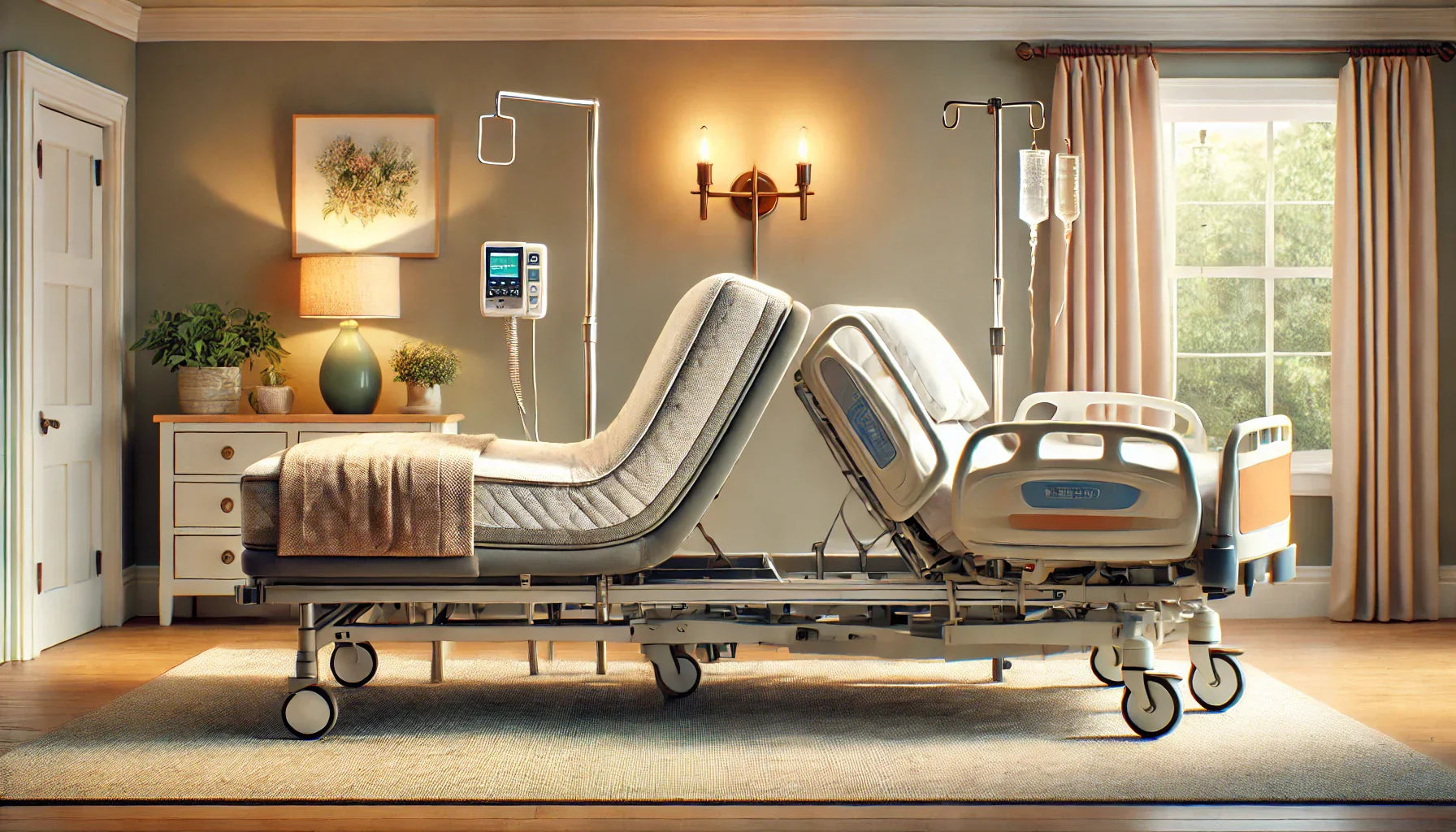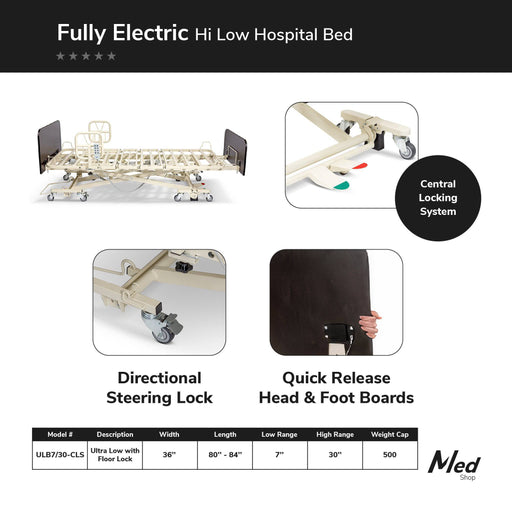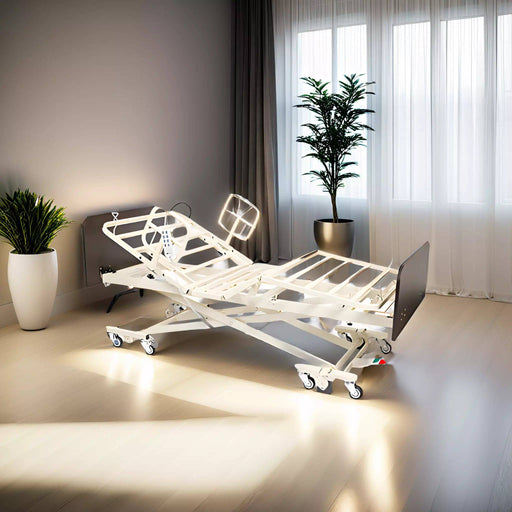
Craftmatic Bed vs Hospital Bed: Compare Options with Adjustable Height AND Rails
KEY TAKEAWAYS
- Craftmatic beds are consumer-focused adjustable beds with lifestyle features but lack medical-grade height adjustability ($1,800-$7,000)
- Hospital beds offer medical features including height adjustment (7"-30" range), safety rails, and clinical positioning ($1,000-$5,000)
- Medicare coverage is typically available for hospital beds when medically necessary but rarely covers Craftmatic or other adjustable beds
- Safety features like medical-grade side rails and height adjustability make hospital beds superior for fall risk and limited mobility
- Transfer safety is significantly better with hospital beds due to adjustable height compared to Craftmatic's fixed-height design
- Caregiver support is enhanced with hospital beds through ergonomic height adjustment and medical integration
- Best overall option: Medacure Ultra Low Hospital Bed ULB3.9 with superior height range (3.9"-26") and medical-grade features
Hospital beds support superior care through:
- Variable height range: Typically 7"-30" from floor to mattress platform
- Medical-grade side rails: FDA-approved safety features for fall prevention
- Clinical positioning: Precise angles for therapeutic needs
- Caregiver ergonomics: Height adjustment reduces strain during care
- Medical integration: Compatible with healthcare accessories
The Medacure Ultra Low Hospital Bed ULB3.9 offers exceptional safety with its ultra-low 3.9" height capability.
Craftmatic beds provide consumer comfort with:
- Fixed bed height without vertical adjustment
- Limited or no medical-grade safety features
- Comfort-focused positioning rather than clinical
- Lifestyle features like massage and USB ports
- More furniture-like residential appearance
When choosing between a Craftmatic bed and a hospital bed, understanding their fundamental differences is crucial. While both offer adjustable positioning, they serve distinctly different purposes that significantly impact safety, functionality, and suitability for various home care situations.
After thorough comparison, the Medacure Ultra Low Hospital Bed ULB3.9 emerges as the superior option for those needing medical-grade features. At $2,240-$2,440, it provides exceptional safety with its ultra-low 3.9" height capability, creating the safest possible environment for those with mobility challenges or fall risks.
In this comprehensive guide, we'll compare Craftmatic adjustable beds with hospital beds, bariatric hospital beds, and analyze their compatibility with hospital bed mattresses to help you make an informed decision based on your specific needs.
Fundamental Differences: Craftmatic vs Hospital Beds
While both offer adjustable positions, these bed types differ significantly in design purpose, features, and core functionality.
| Feature | Hospital Beds | Craftmatic Beds |
|---|---|---|
| Primary Purpose | Medical care and patient safety | Comfort and lifestyle enhancement |
| Height Adjustment | Yes - typically 7"-30" range | No - fixed height |
| Side Rails | Integrated, medical-grade | Not standard, sometimes available |
| Position Control | Medical-grade articulation | Basic head/foot elevation |
| Medical Integration | Compatible with healthcare equipment | Limited medical compatibility |
| Frame Design | Healthcare-grade construction | Residential furniture design |
| Weight Capacity | 450-1000 lbs (standard to bariatric) | 300-450 lbs (varies by model) |
| Primary Market | Medical and healthcare use | Residential consumer market |
Hospital Beds: Medical-Grade Features
Hospital beds offer healthcare features:
- Height adjustability (Hi-Lo function): Raise for caregiver access, lower for safer transfers
- Medical-grade side rails: FDA-approved safety features for fall prevention
- Clinical positioning: Precise angles for therapeutic needs
- Caregiver ergonomics: Height adjustment reduces strain during care
- Medical integration: Compatible with healthcare accessories
The Costcare Full Electric Hospital Bed B135C showcases these medical-grade features at $1,298.
Craftmatic Beds: Consumer-Focused Design
Craftmatic beds focus on lifestyle features:
- Fixed bed height: No vertical adjustment capability
- Comfort-oriented: Designed for reading, TV viewing, and sleep comfort
- Aesthetic priority: More furniture-like appearance
- Consumer features: Often includes massage, USB ports, under-bed lighting
- Standard sizes: Available in residential twin, full, queen, and king
Craftmatic beds typically offer:
- Wireless remote control
- Memory position settings
- Massage functions (various levels/zones)
- Designer upholstery options
- Split adjustability for couples
Critical Safety Comparison for Home Care
Safety features represent one of the most significant differences between these bed types, particularly for individuals with mobility challenges.
Fall Prevention and Management
Hospital beds excel in fall prevention through:
- Ultra-low height settings: Models like the Medacure Ultra Low Hospital Bed ULB7/30-CLS can lower to just 7" from the floor ($1,741)
- Integrated side rails: Prevent rolling off while providing repositioning support
- Optimal transfer height: Can be set precisely for each individual's safe transfers
- Bed exit alarms: Available on some models to alert caregivers
- Locking mechanisms: Secure the bed in place to prevent unwanted movement
Craftmatic beds provide limited fall protection with:
- Fixed height that cannot be optimized for transfer safety
- Optional side rails that aren't medical-grade
- No emergency lowering capabilities
- Limited adaptability for changing mobility needs
- No medical certification for fall prevention
Side Rails and Mobility Support
Hospital bed rail options include:
- Full-length rails: Maximum protection for high fall risk
- Half-rails: Balance between protection and accessibility, like the Costcare Homecare Half Rails
- Quarter rails: Primarily for grip assistance
- Assist bars: Help with sitting up and repositioning
- Anti-entrapment design: Prevent dangerous gaps and comply with FDA guidelines
Hospital bed rails offer superior support for:
- Safe bed entry and exit
- Stability during position changes
- Self-repositioning assistance
- Exercise and strength maintenance
- Caregiver leverage during care
Craftmatic bed rail limitations include:
- Typically aftermarket additions rather than integrated design
- Not designed to medical safety standards
- Limited regulatory oversight for entrapment prevention
- Reduced effectiveness during articulation
- Fewer options for progressive mobility support
Caregiver Assistance Features
Hospital beds support caregiving through:
- Ergonomic height adjustment: Raises to optimal working height to prevent back strain
- Multiple control options: Bed-mounted, handheld, and side rail controls
- Caregiver lock-out features: Prevent unintended patient adjustments
- Medical-grade durability: Designed for frequent repositioning and care
- Healthcare integration: Compatibility with medical accessories and equipment
The TransferMaster Full Electric Hi-Lo Hospital Bed Supernal 3 features exceptional caregiver support starting at $3,441.
Craftmatic beds present caregiver challenges including:
- Fixed height creating ergonomic strain during care
- Limited access for bathing and hygiene assistance
- Fewer secure grip points for repositioning
- Reduced compatibility with medical equipment
- No specialized caregiver controls
Positioning and Therapeutic Benefits
Both bed types offer position adjustability, but with significant differences in therapeutic capability.
Clinical Positioning Options
Hospital beds offer therapeutic positioning including:
- Trendelenburg: Feet elevated above head for circulatory needs
- Reverse Trendelenburg: Head elevated above feet for respiratory support
- Cardiac chair: Specialized position supporting heart function
- Precise articulation: Exact angles for medical conditions
- Position memory: Save prescribed therapeutic settings
The Trendelenburg Costcare Adjustable Medical Bed B337 provides these specialized medical positions for $1,675.
Craftmatic beds typically offer:
- Basic head and foot incline
- Zero-gravity positioning (on some models)
- Limited angle range compared to medical beds
- Fewer articulation points
- Positions designed for comfort rather than therapeutic benefit
Pressure Relief and Mattress Compatibility
Hospital beds work with specialized medical mattresses:
- Segmented design: Specifically engineered to flex with bed articulation
- Pressure redistribution: Zoned to prevent pressure ulcers
- Therapeutic surfaces: Compatible with alternating pressure and low air loss systems
- Edge reinforcement: Enhanced support during transfers
- Medical-grade materials: Antimicrobial, fluid-resistant, flame-retardant
The Emerald 5-Zone Medical Foam Mattress exemplifies these specialized pressure relief features.
Craftmatic beds typically use:
- Standard or split consumer mattresses
- Materials prioritizing general comfort over medical needs
- Limited pressure redistribution capability
- Non-medical coverings without healthcare features
- Less effective articulation during adjustment
Cost Considerations and Insurance Coverage
The financial aspects of these beds extend beyond just the initial purchase price.
| Cost Factor | Hospital Beds | Craftmatic Beds |
|---|---|---|
| Base Price Range | $1,000-$5,000+ | $1,800-$7,000+ |
| Medicare Coverage | Yes - when prescribed | Rarely covered |
| Private Insurance | Often covered with documentation | Generally not covered |
| True Cost After Coverage | Can be significantly lower | Full retail price |
| Typical Lifespan | 10-15 years | 7-10 years |
| Additional Costs | Medical mattress ($300-$2,000) | Aftermarket safety features ($200-$500) |
Medicare and Insurance Coverage
Hospital beds may qualify for coverage when:
- Prescribed by a physician as medically necessary
- Provided through Medicare-approved suppliers
- Meeting specific Medicare codes and requirements
- Documented with proper medical justification
The Costcare Semi-Electric Bed B120C at $1,068 represents an excellent value option that typically qualifies for coverage.
Medicare coverage typically includes:
- 80% of approved amount after deductible
- Rental or purchase options depending on expected use duration
- Coverage for necessary accessories
- Possible supplemental coverage for remaining 20%
Craftmatic beds rarely qualify for coverage because:
- They're classified as comfort items rather than medical devices
- They lack medical certifications and features
- They don't meet durable medical equipment standards
- They're not coded for medical reimbursement
This coverage difference can make hospital beds significantly more affordable despite potentially higher list prices.
Specific Needs Assessment: Which Bed Type Works Best?
Different scenarios require different bed features. Here are recommendations based on specific needs.
For Fall Risk and Limited Mobility
Best option: Ultra Low Hospital Bed Medacure ULB3.9 ($2,240-$2,440)
- Industry-leading 3.9" minimum height
- Medical-grade side rails
- Full electric controls
- Stable locking mechanism
- Ideal for high fall risk and very limited mobility
Another excellent choice: Low Profile Hospital Bed Prius Descend Ultra for $2,450
Not recommended: Craftmatic beds lack the height adjustability and safety features needed for significant fall risks.
For Those Needing Caregiver Assistance
Best option: Medacure Split Frame LX-BARI Adjustable Hospital Bed ($2,558)
- Height adjustability for caregiver ergonomics
- Split frame design for precise positioning
- Options for wider surface when needed
- Caregiver-friendly controls
- Excellent durability for long-term use
Craftmatic limitations for caregiving: Fixed height creates ergonomic challenges, limited access for care activities, and minimal integration with care equipment.
For Comfort with Minimal Medical Needs
Best hospital bed for aesthetic comfort: Icare Adjustable Electric Home Hospital Bed IC333 ($3,200)
- Residential appearance
- Full medical functionality
- Home-friendly design
- Height adjustability for future needs
- Balance of comfort and medical features
When Craftmatic might be suitable: For individuals with excellent mobility, minimal medical needs, no fall risk, and no requirement for caregiver assistance, a Craftmatic bed could be appropriate.
For Bariatric Needs
Best bariatric option: Heavy Duty Hospital Bed Costcare B357 ($3,142)
- 600 lb weight capacity
- Flexible width (42"-48") options
- Reinforced frame construction
- Heavy-duty motors
- Bariatric bed with height adjustability
For higher weight capacities, consider the Medacure Bariatric Adjustable Bed Lincoln LX-BARI-S with support up to 750 pounds and a built-in scale at $3,495.
Craftmatic bariatric limitations: Less robust weight ratings, limited frame durability, and reduced position stability compared to medical-grade bariatric beds.
Our Top Recommendation: Hospital Bed for Most Home Care Needs
After thorough comparison of Craftmatic beds and hospital beds across multiple factors, the Medacure Ultra Low Hospital Bed ULB3.9 emerges as our top recommendation for most home care situations.
This exceptional hospital bed offers:
- Industry-leading ultra-low height capability (3.9" from floor)
- Full electric functionality for all positions
- Excellent safety features for fall prevention
- Medical-grade construction and durability
- Compatibility with therapeutic mattresses and accessories
For those prioritizing aesthetic appearance with medical functionality, the Icare Adjustable Electric Home Hospital Bed IC333 provides an excellent balance at $3,200.
For budget-conscious buyers still needing medical features, the Costcare Semi-Electric Bed B120C offers essential functions at $1,068.
Frequently Asked Questions
Will Medicare cover a Craftmatic bed like they do for hospital beds?
Medicare rarely covers Craftmatic beds or other consumer adjustable beds because they're classified as comfort items rather than medical devices. To qualify for Medicare coverage, a bed must include specific medical features including height adjustability, clinical positioning capabilities, and meet durable medical equipment (DME) standards. Hospital beds that meet these criteria are typically covered at 80% of the approved amount when prescribed by a physician as medically necessary. This coverage difference can make hospital beds significantly less expensive after insurance despite their potentially higher retail price.
Can a Craftmatic bed be modified to have similar safety features as a hospital bed?
While some modifications can be made to Craftmatic beds, they cannot be fully converted to match hospital bed safety features. Possible additions include aftermarket side rails (though these won't match medical safety standards), transfer boards and step stools for safer access, and pressure-relief mattress toppers. However, the most critical hospital bed feature—height adjustability—cannot be added to a Craftmatic bed as it requires a completely different frame design. Other features that cannot be adequately replicated include medical-grade articulation, true clinical positioning options, and integration with healthcare accessories.
Which bed type is better for someone recovering from surgery at home?
For most post-surgical recovery situations, a hospital bed is significantly better than a Craftmatic bed. Hospital beds offer: height adjustability for safer transfers when mobility is limited, precise positioning for specific surgical recovery needs, superior caregiver access for wound care and assistance, and integration with medical accessories that may be needed during recovery. The exception would be for minor procedures with very short recovery periods and fully mobile patients, where a Craftmatic bed might be sufficient. For any recovery involving significant mobility limitations or requiring caregiver assistance, a hospital bed provides much better support and safety.
Do hospital beds always look institutional, or are there more home-friendly options?
Modern hospital beds have significantly improved in appearance, and many now feature residential-style designs that blend well in home environments. Models like the Icare Adjustable Electric Home Hospital Bed IC333 specifically focus on combining medical functionality with home-friendly aesthetics. Other options to enhance appearance include decorative wood-finish headboards and footboards, bed skirts and coverlets that conceal mechanical components, designer color options beyond traditional white, and furniture-quality side panels. Many manufacturers now offer design consultations to help integrate their hospital beds into residential settings.
Which mattress works best with each bed type for maximum comfort?
Hospital beds require specialized mattresses designed to articulate properly with their frames. For maximum comfort while maintaining therapeutic benefits, the best options include segmented memory foam hospital mattresses (like the TransferMaster Soft Touch Memory Foam Hospital Bed Mattress), gel-infused pressure relief mattresses (such as the ICare IC30 ActiveX Gel-Infused Hospital Bed Mattress), or hybrid designs with multiple support zones. Craftmatic beds typically use split residential mattresses made from memory foam, latex, or hybrid materials. While these can be comfortable, they lack the medical design elements of hospital mattresses and may create pressure points during articulation. Always ensure any mattress is specifically designed for the bed type you select.
What are the key differences in durability and long-term value between these bed types?
Hospital beds typically offer superior long-term value despite sometimes higher initial costs. They feature medical-grade construction with 10-15 year typical lifespans even under intensive use, parts that are designed for replacement and readily available, serviceability by medical equipment technicians, potential insurance coverage that reduces out-of-pocket expenses, and adaptability to changing health needs over time. Craftmatic beds generally have consumer-grade construction with 7-10 year expected lifespans, proprietary parts that may be harder to source after warranty periods, limited serviceability options, no insurance coverage potential, and less adaptability to progressive health changes. For long-term care situations, hospital beds typically provide better overall economics despite potentially higher initial price points.




















